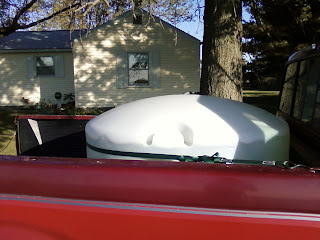If I ever had the illusion that taking honey from my bees was anything but thievery, they have changed my mind. Early yesterday evening, R and I gathered our tools, suited up, lit the smoker and cracked open the established hive in search of honey.
It has been a couple of years since there has been any honey to harvest. My original colony, the one we robbed yesterday, produced nearly three gallons of honey its first year. Then the winter of 2010-2011 came with months of cold, harsh weather. The colony was quite weak entering the spring and it took all summer for the bees to build up. By fall, they were looking great, but there was no time for them to make surplus honey for me.
Fortunately for the bees, last winter was mild and they came into this spring as strong as they had been the previous fall. Maybe too strong for their own liking. In May, the colony sent off a swarm into a dead tree on the property line. Luckily, R spotted it and with his help, a 6 foot ladder, and a large plastic tote, we capured the swarm. About a week later, the hive sent off another, smaller swarm called an after-swarm. We captured this swarm as well, but must not have got the queen because the bees disapperared from their new hive without any signs of swarming. My assumption is that some went back to their old home and some joined the first swarm that was getting established in a single, Langstroth hive body nearby.
All that to say that the original colony has been very active and the queen has been laying new baby bees like a champ!
This spring I placed two shallow honey supers on the hive in anticipation of the May/June nectar flow. By mid-June the bees had filled up the lower super with honey, but nothing in the top. Last night, we smoked the bees in an attempt to drive them down into the lower hive bodies so we could take the top boxes with a minimum amount bees. It did not go according to plan. The bees would not leave. We then removed the supers and carried them across the yard to blow out the bees using an air compressor hose. This resulted in a lot of bees, now angry and disoriented, wildly flying around us. It rapidly became apparent that we were not going to be able to remove enough bees to place the supers, complete with frames, in garbage bags as planned. R then suggested that we clean off the bees a frame or two at a time and then place the frames in the deep freeze to kill off any remaining bees. The frames could then be removed in a couple of days, placed back in the boxes and then into garbage bags where they could thaw before extraction on Saturday.

This worked better than anything thus far. As R removed frames, I gave them a quick shot of air from the hose and hustled them into the garage freezer. R observed that all the insanity with thousands of flying insects was almost as good an adrenaline rush as go-kart racing. That may have been the beestings talking.
To my surprise, after we finished cleaning up the mess, R wanted to move on to the top bar hive to see what the newer colony had been doing. It was a good thing that we did. The bees had been very busy making, what I consider to be, quite a mess. In the 100 degree heat of July, I had propped open the lid of the hive to allow for better circulation. The bees had designs for what to do with the newfound "attic space." They filled it wth burr comb and honey! Though I hated to do it, the comb had to be removed, otherwise the lid could not be closed for the winter. We layed out a plastic garbage bag in front of the hive and then placed all the cut comb on it. As temping as it was to take this honey for ourselves, the colony is just getting started and will need all the honey it can store to get through its first winter.


The bees are busy today at both hives cleaning out comb and frames and should have all the excess honey back in their hives in a few days. The empty honeycomb will be added to my "wax bucket" for future lip balm and candles. Honey extraction will take place at my mentor's garage on Saturday. I should be able to get better pictures without angry bees attacking me. I will never fool myself into believing that I am just "harvesting" honey again. I am definitely stealing it.




































